The Salar de Uyuni is the biggest salt flat in the world and the most famous tourist draw in Bolivia, South America. In fact, for many travelers, the Bolivian Salt Flats is the sole reason they visit Bolivia. We do recommend that you visit more of Bolivia than just the salt flats, but if you want some epic pictures and an unforgettable experience you will want to put the Salar de Uyuni Salt Flats on your bucket list.
Ever since the Bolivia Salt Flats played host to the world-famous Dakar Rally in 2014, it has gained even more attention amongst travelers. “You will love it!” These were the words we had heard from other travelers every time we mentioned our plan to travel to the Bolivia Salt Flats. As you might imagine our expectations were sky-high and we couldn’t wait to see the white endless scenery.
Table of Contents
What is the Salar de Uyuni, Bolivia?
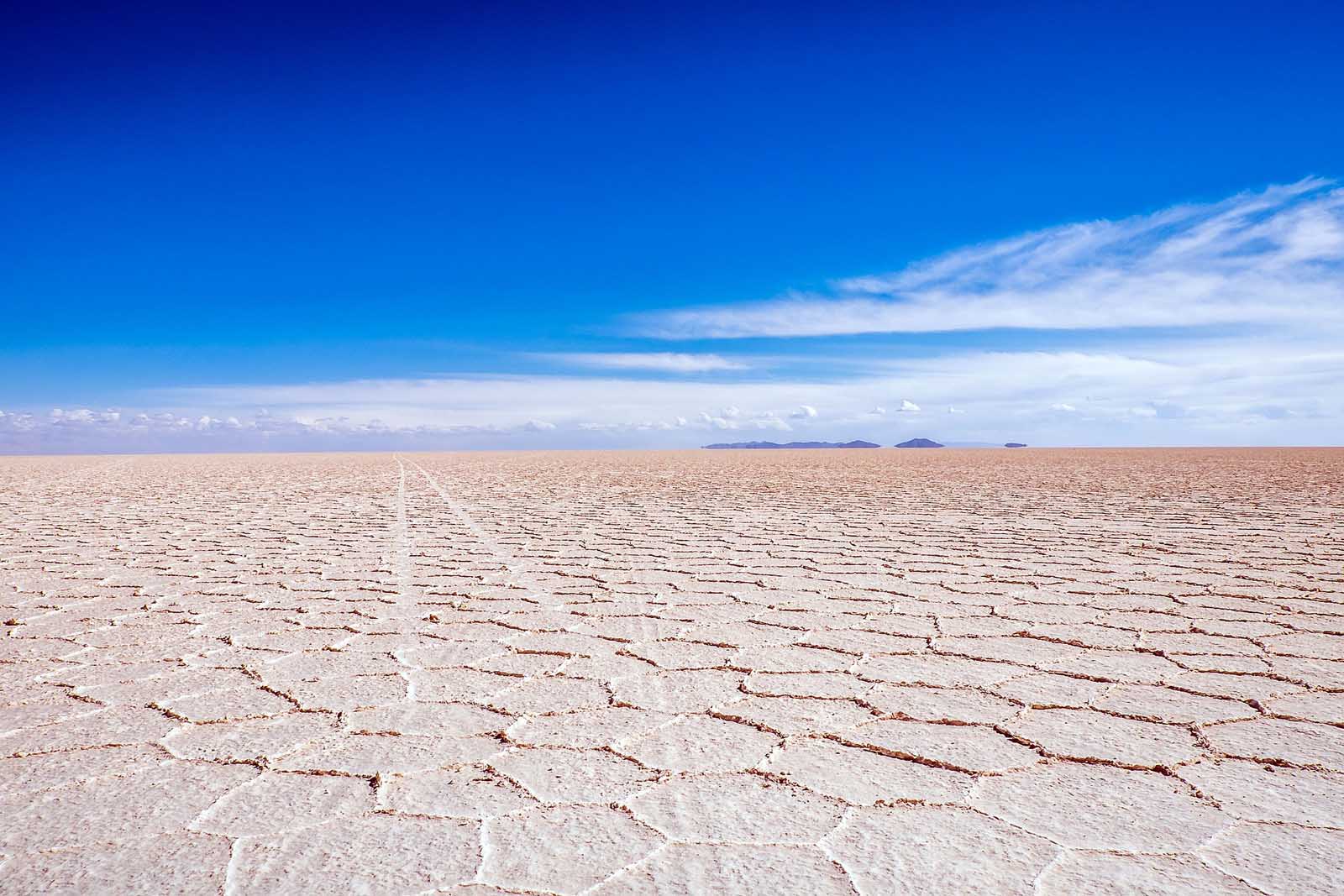
The Salar de Uyuni is one of the most spectacular adventure-travel destinations on Earth. Think 10 billion tons of salt sprawling across an endless desert. The Salar de Uyuni is a 10,582 square kilometer expanse of cracked white salt, left behind when an ancient salt lake named Coipasa dried up thousands of years ago.
Located in the Bolivian Altiplano, it is the world’s largest salt flat and is located at a high altitude of 3,656 meters (10,000 feet) above sea level.
Salar de Uyuni is made primarily of salt. It is a vast expanse of dried-up prehistoric lakes, and the salt flat itself is the result of the evaporation of water from these ancient lakes. Underneath the salt crust lies a thick layer of brine, which is a concentrated solution of salt and water.
The salt crust on the surface is composed mainly of sodium chloride (table salt) along with other minerals such as magnesium, potassium, and lithium. These minerals give the salt flat its unique colors and patterns. In fact, Salar de Uyuni is not just a salt flat but also contains significant lithium reserves, making it a valuable resource.
During the dry season, the salt crust hardens and forms a vast white landscape, creating a surreal and otherworldly appearance. However, in the rainy season, the flat transforms into a massive reflective surface, resembling a giant mirror due to a thin layer of water that covers the salt crust. This phenomenon creates stunning optical illusions and unique photo opportunities for visitors.
Uyuni Salt Flats Day Tours
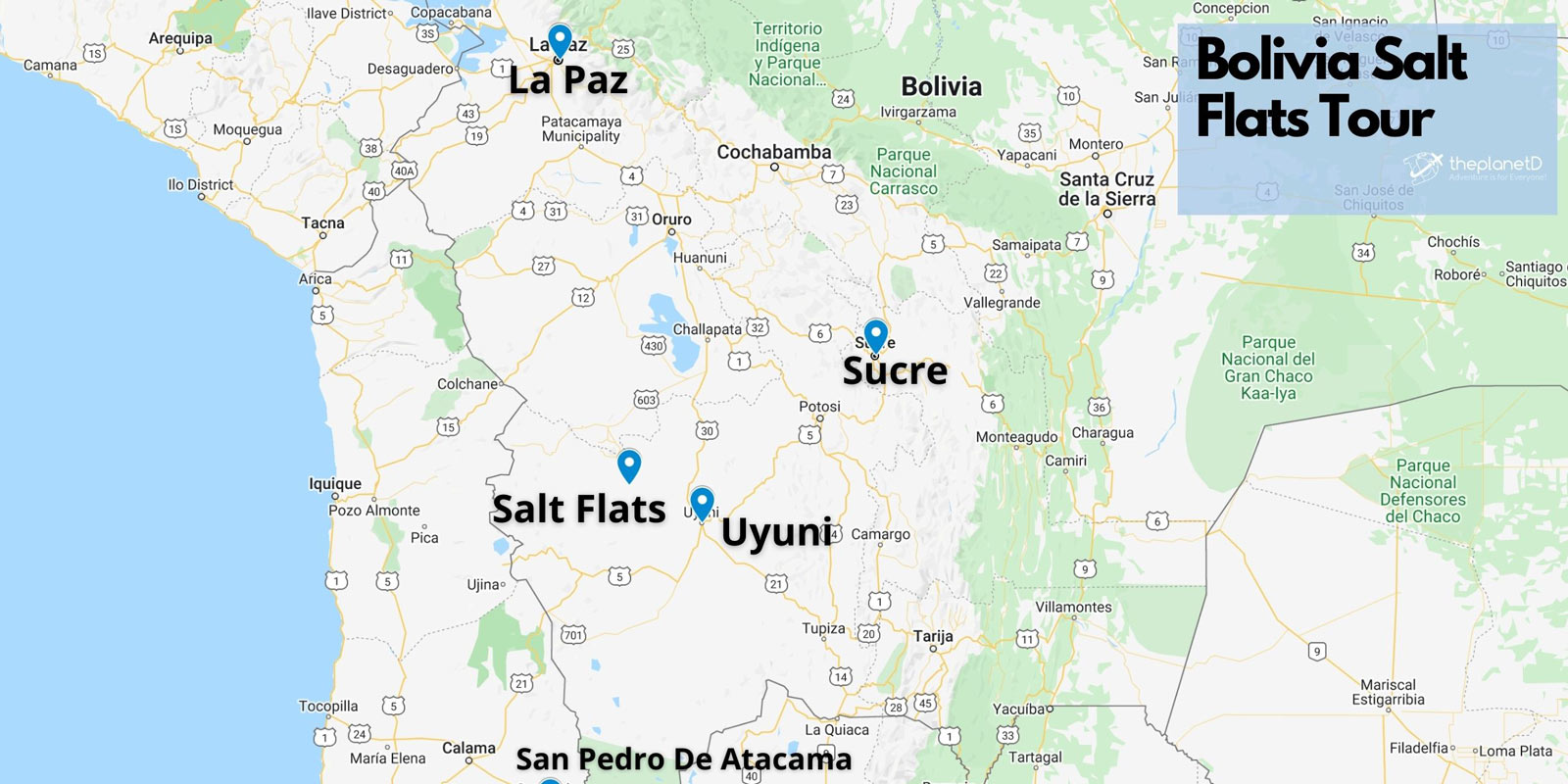
The beauty is that the tours are flexible. There are options for 1 day, 3 days, or 4 days, depending on what your schedule is and how much time you want to spend in the area itself. We recommend the 3 or 4-day option as it covers the most.
Most Salar de Uyuni, including ours, meant spending four days locked in a jeep with three other travelers and a cook while our amiable Bolivian driver took us through an increasingly unbelievable array of natural wonders. This is the best way to see the Uyuni salt flats in my opinion.
We have included a map below to give you an idea of where in Bolivia the slat flats are in relation to the rest of the country.
Where do Bolivia Salt Flats Tours Start From?
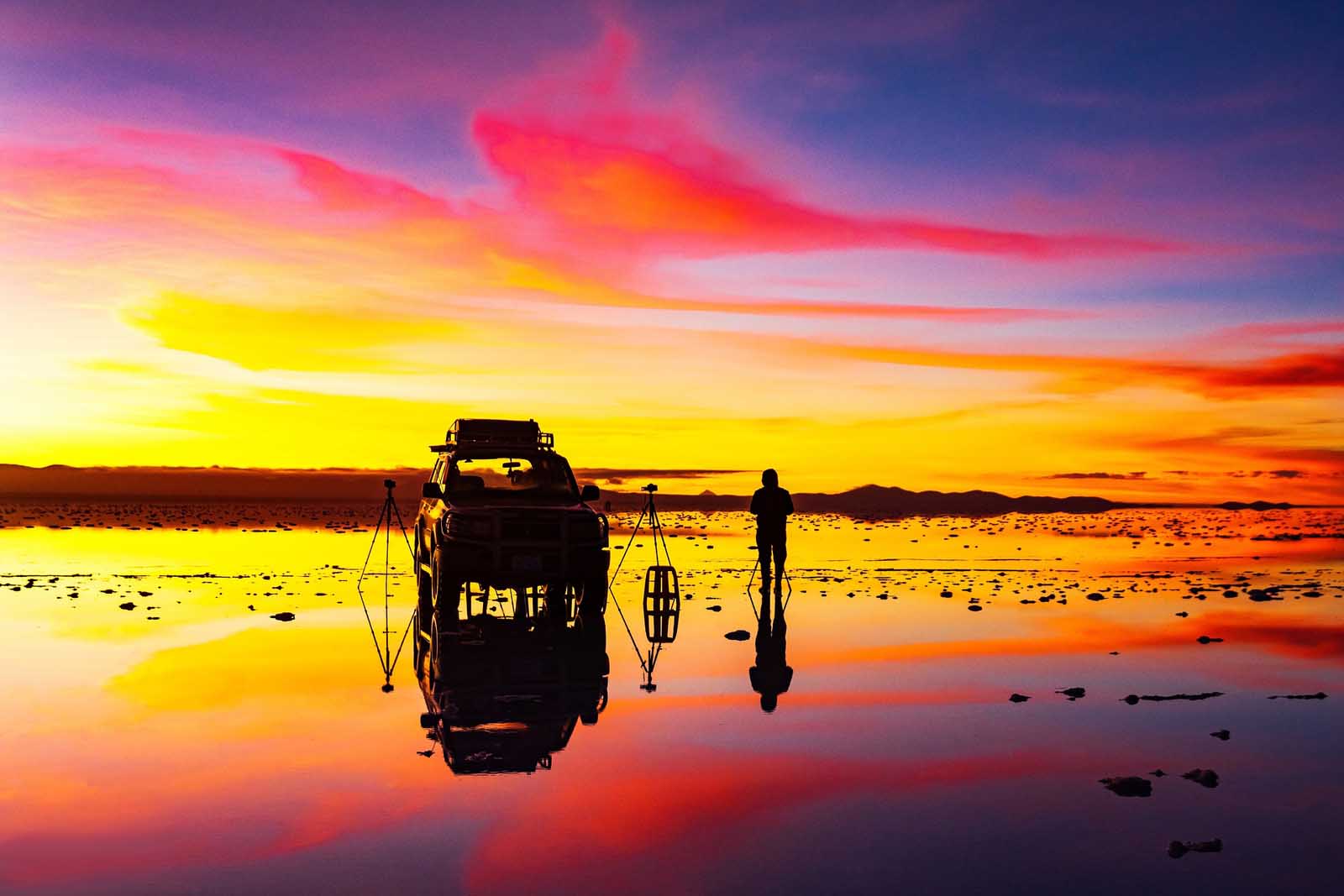
The beauty of the Salt Flats being so popular is that tours to the area start from a number of different places. For the most part, the length of your salt flats tour will determine where you start.
Start and End in Uyuni
Most tours of Salar de Uyuni leave from the town of Uyuni itself, a dry desert settlement located near the salt flats. It’s by far the cheapest place to pick up a tour, with trips on offer for as low as B$600 (about $80 USD). This is most likely the place you will start out if you are doing a 1 Day tour of the salt flats. We do recommend being cautious and doing your research as we found that quite a few of the tour agencies in Uyuni tout unreliable cars and dangerous drivers.
If you are planning a 3 or 4-day tour then there are a lot more options to choose from when it comes to a starting point and an ending point.
Start in Tupiza End in Uyulni
A more pleasant (if slightly pricier) experience can be had by taking the back road to the Salar, leaving from the south-Bolivian city of Tupiza. Home to a handful of tour agencies and a pleasant main plaza, Tupiza is a relaxing place to spend a couple of days while researching agency options. Tours from here usually last 4 days and at the end, you can return to Tupiza from Salar de Uyuni if you like.
Start in Uyuni End in San Pedro de Atacama in Chile
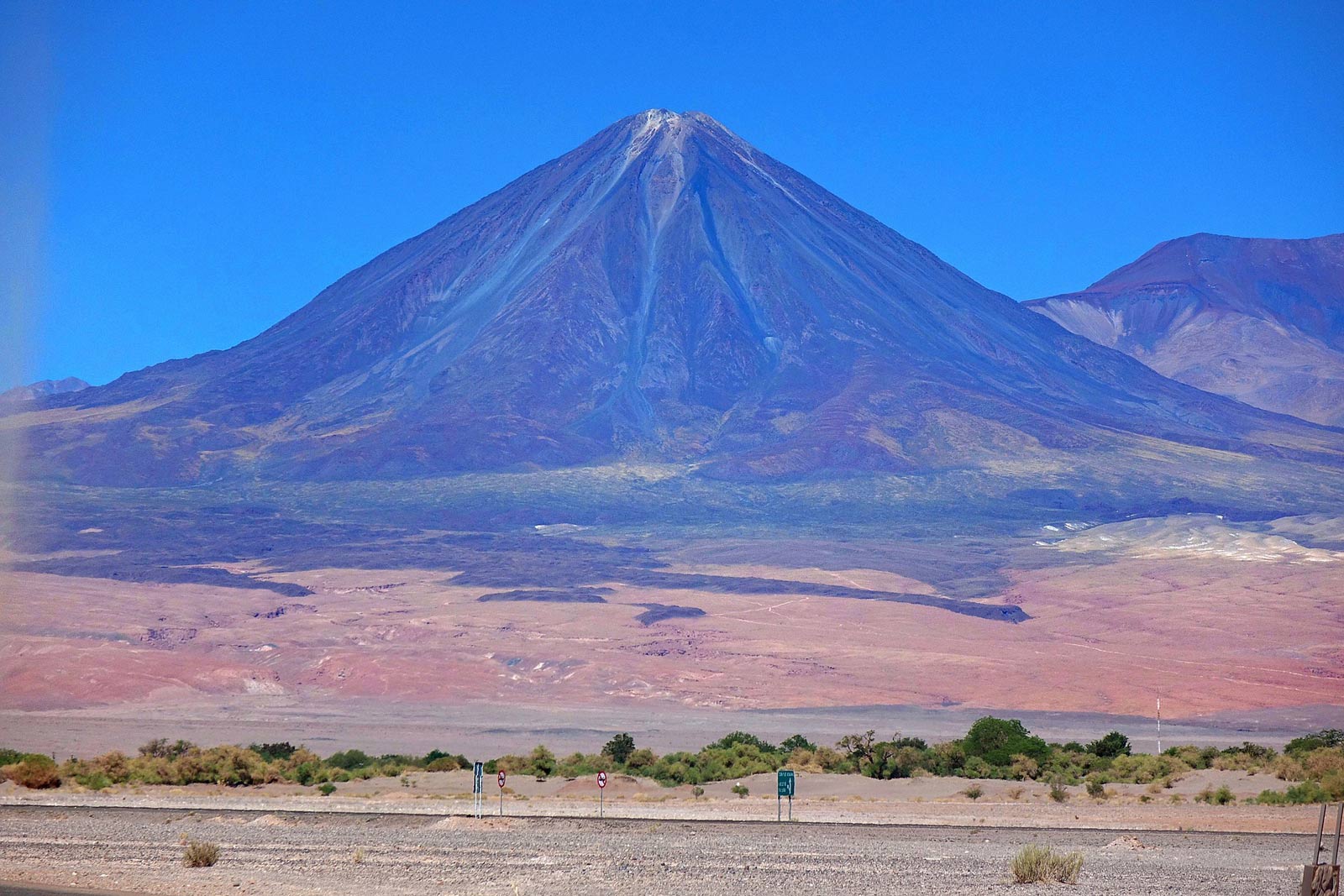
This is the most popular option, especially if you are looking at a multi-day tour. Alternatively, if you have money to burn, you could begin your tour from San Pedro de Atacama, a beautiful (if absurdly touristy) village in nearby Chile.
Located on Chile’s border with Bolivia, San Pedro de Atacama is surrounded by spectacular scenery of its own to explore–but it’s not for the faint of wallet. This is one of the reasons we recommend booking the tour that starts in Uyuni and ends in Chile at San Pedro de Atacama.
Altitude Sickness
If you do decide to start in San Pedro remember that you will be at a high altitude, so there is a risk of altitude sickness if you don’t take care to acclimate. Drink plenty of water and don’t over-exert.
At this high of elevation, there is a real threat of getting sick. Keep an eye out for altitude sickness symptoms which include headache, nausea, and vomiting when severe. We recommend visiting a travel clinic before visiting Salar de Uyuni. Your doctor may prescribe Diamox. Locals also recommend coca tea made from coca leaves.
La Paz or Sucre
If you are looking just for a quick day tour of the salt flats then you can easily jump on one in either La Paz or Sucre, if you are in those cities and you have a limited amount of time.
How Many Days in the Bolivia Salt Flats Do You Need?
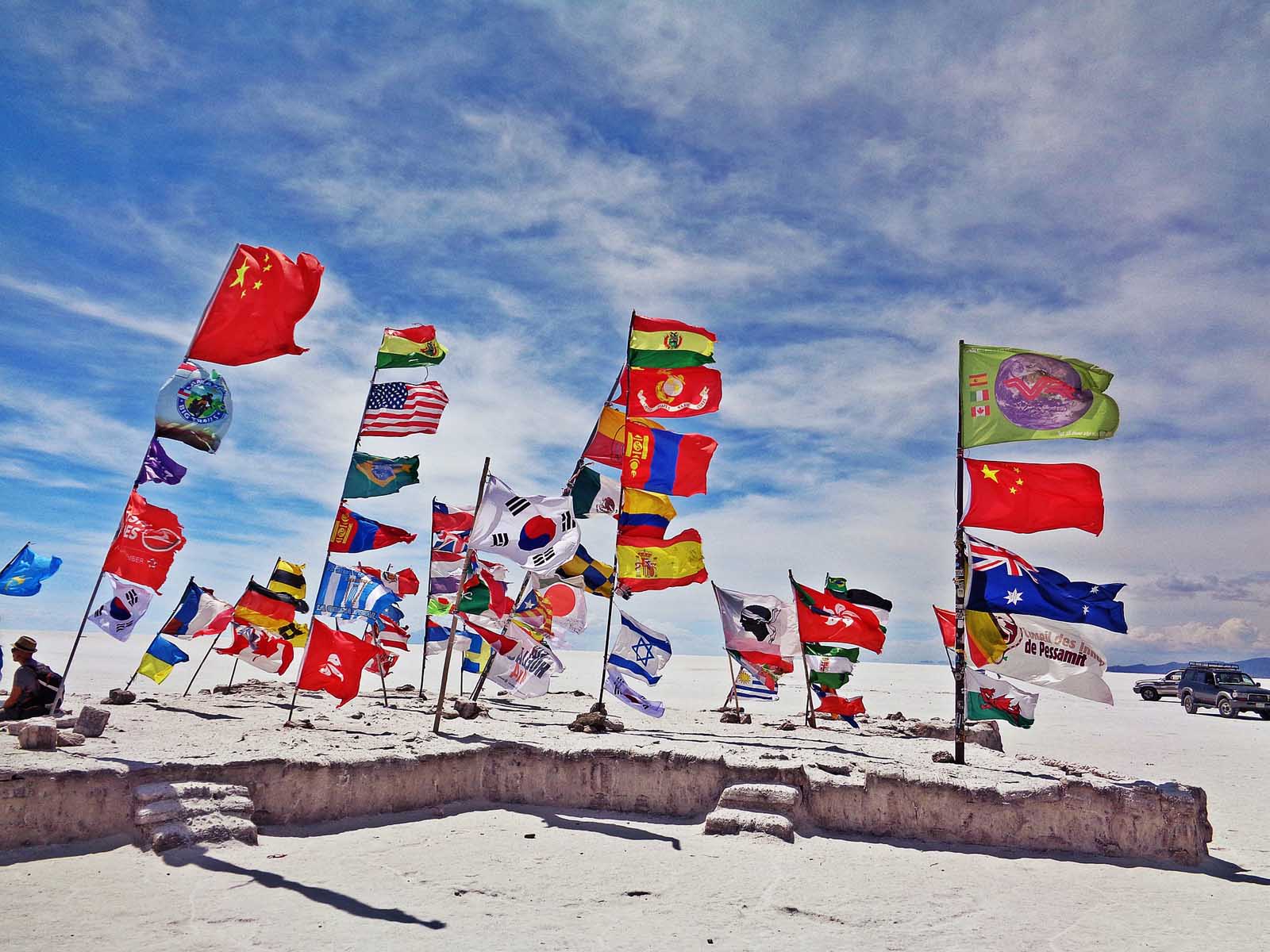
We recommend the 3 or 4-day tour of the Uyuni Salt Flats. Although you can do a 1-day tour of the salt flats themselves you really do miss out on the other attractions that are covered in the 3 and 4-day tour. The longer tours are more popular for this reason.
Of course, it will all depend on your budget and travel itinerary which length of trip you choose. Just be aware that on the 1-day tour you miss out on the hot springs, the volcano, and the flamingoes and you don’t get the chance to see this amazing sight at sunset. Being a photographer this is a must!
The 3-day tour of the Uyuni Salt Flats is the perfect amount of time to balance being at altitude and seeing it all.
How to Choose Your Bolivia Salt Flats Tour
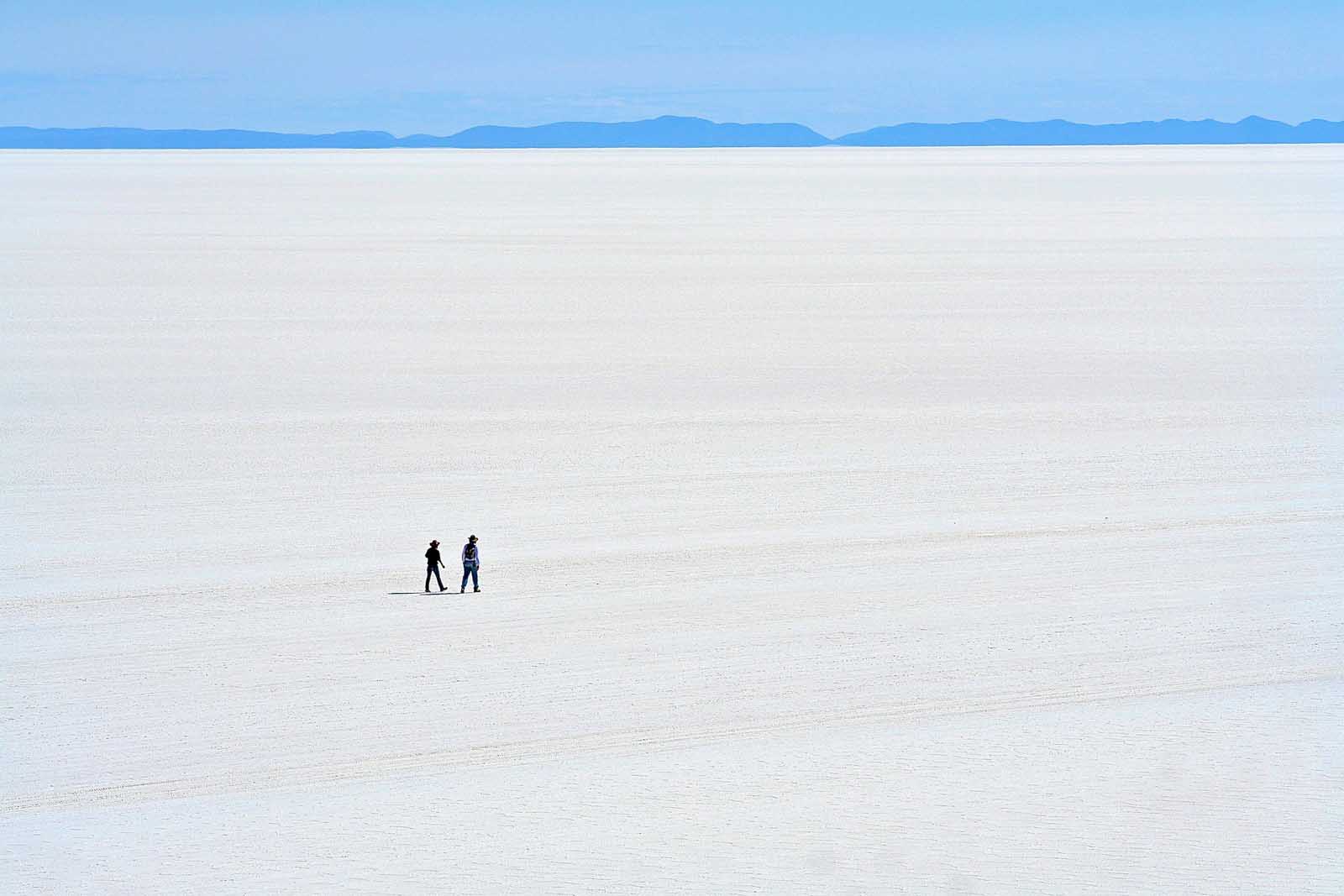
There are many tour agencies and many drivers offering tourists an Uyuni experience-but not all of them are reliable. Drunken drivers and sham agencies abound, so be sure to research your options carefully and meet your driver before putting down money. If things seem shady, don’t be afraid to back out.
Some tour operators are all too good at pressuring tourists to ignore their better instincts. The agency I chose was named Natural Adventure, an operator based out of the small Bolivian city of Tupiza.
I had a very good experience with them; though my driver didn’t speak much English, he made up for it with friendliness, verve, and expressive hand gestures.
The truth is that all the tours will cover the same things. It is pretty standard. They will try and upsell you and convince you that they have faster cars or better accommodation just to get more money out of you. If you ask the right questions you will definitely up your chances of getting a great tour.
Recommended Tours to Book Ahead of Time
Questions to Ask Before Booking a Tour to the Uyuni Salt Flats
- How Many People will be in my car? Obviously the smaller amount of people the better. But most tours try and get 6 people plus a driver in a vehicle.
- What type of accommodations are offered? Will you be staying in a salt hotel, sharing a room, or all in one big room?
- Does my driver speak English? Most drivers are also your guide and cook and don’t speak much english. It helps if you know some spanish or you are good at acting things out.
- Is the entrance to the National park included? The usual answer to this is no, but some do offer it. If it is not then be prepared to fork over an extra of 150 Bob ($22 USD). If you plan on visiting “Fish Island” within Uyuni salt lake that will cost you extra as well.
- Where does the tour end? Will you be coming back to Uyuni or doest t finish in another destination like San Pedro de Atacama in Chile. The coice is usually yours.
How Much Does it Cost to Visit the Bolivia Salt Flats?
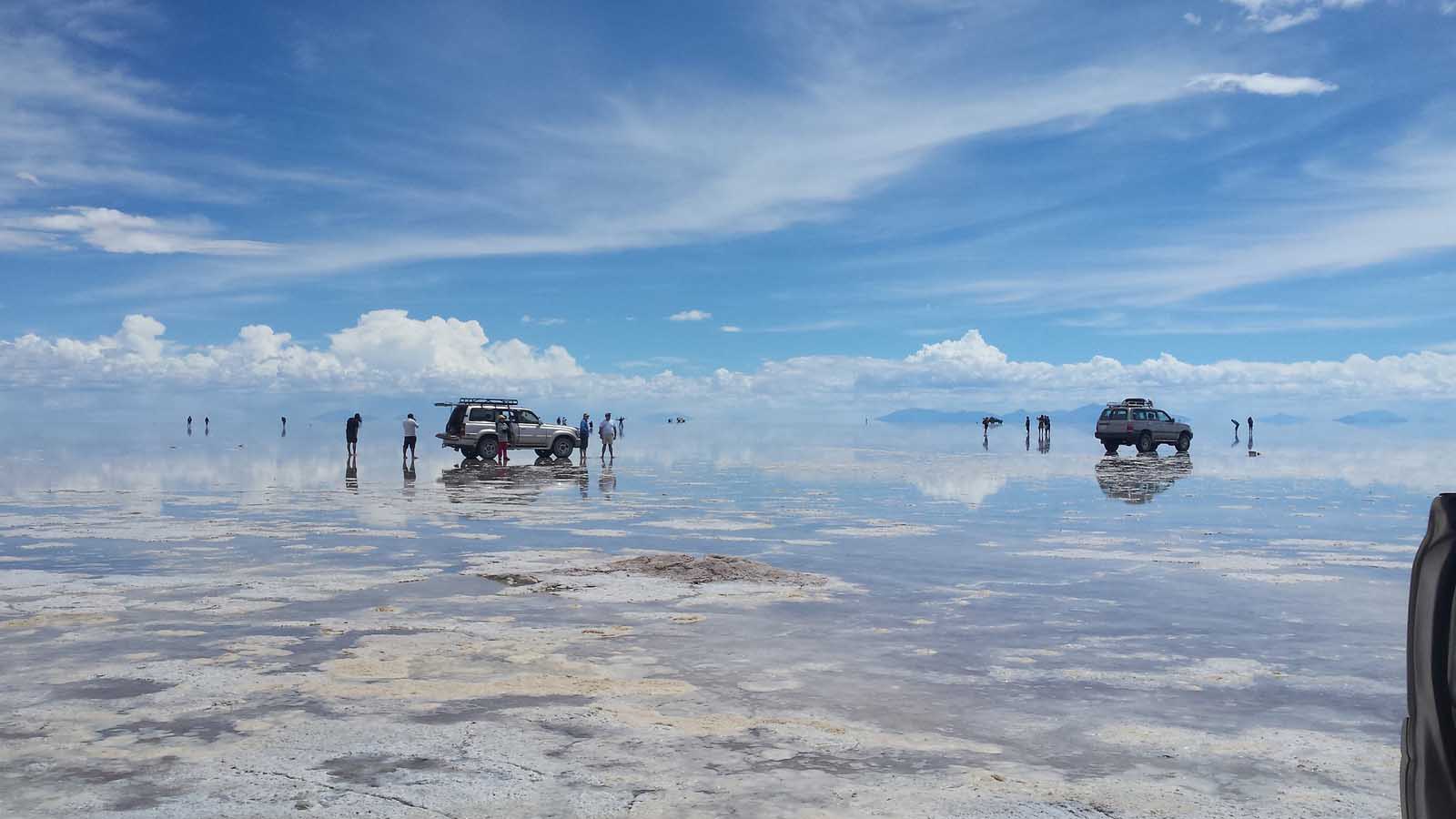
As we said above, all of the tours are the same and follow the same route. Do not be fooled by people trying to upsell you to a better tour. The car and the accommodation may change but the tours themselves are identical. That being said the price varies widely, so you are going to have to negotiate the best price.
You should not pay more than 850-1350 Bob for a 3-day tour ($125 – $195 USD). This price is all-inclusive of food, transportation, accommodation, and a Spanish-speaking guide. If you want an English-speaking guide prepare to pay double. What it does not include is the $20 fee to get into the National Park, so make sure you have cash for that. If you are planning on going to San Pedro de Atacama then you will also need 50 Bob for the border crossing. It is always good to have some cash on you.
It is important to note that the prices above are if you book your tour on arrival or in Bolivia itself. If you book your tour online before you travel the cost can be almost double.
What are the Accommodation Options on the Salar de Uyuni Salt Flats Tours?
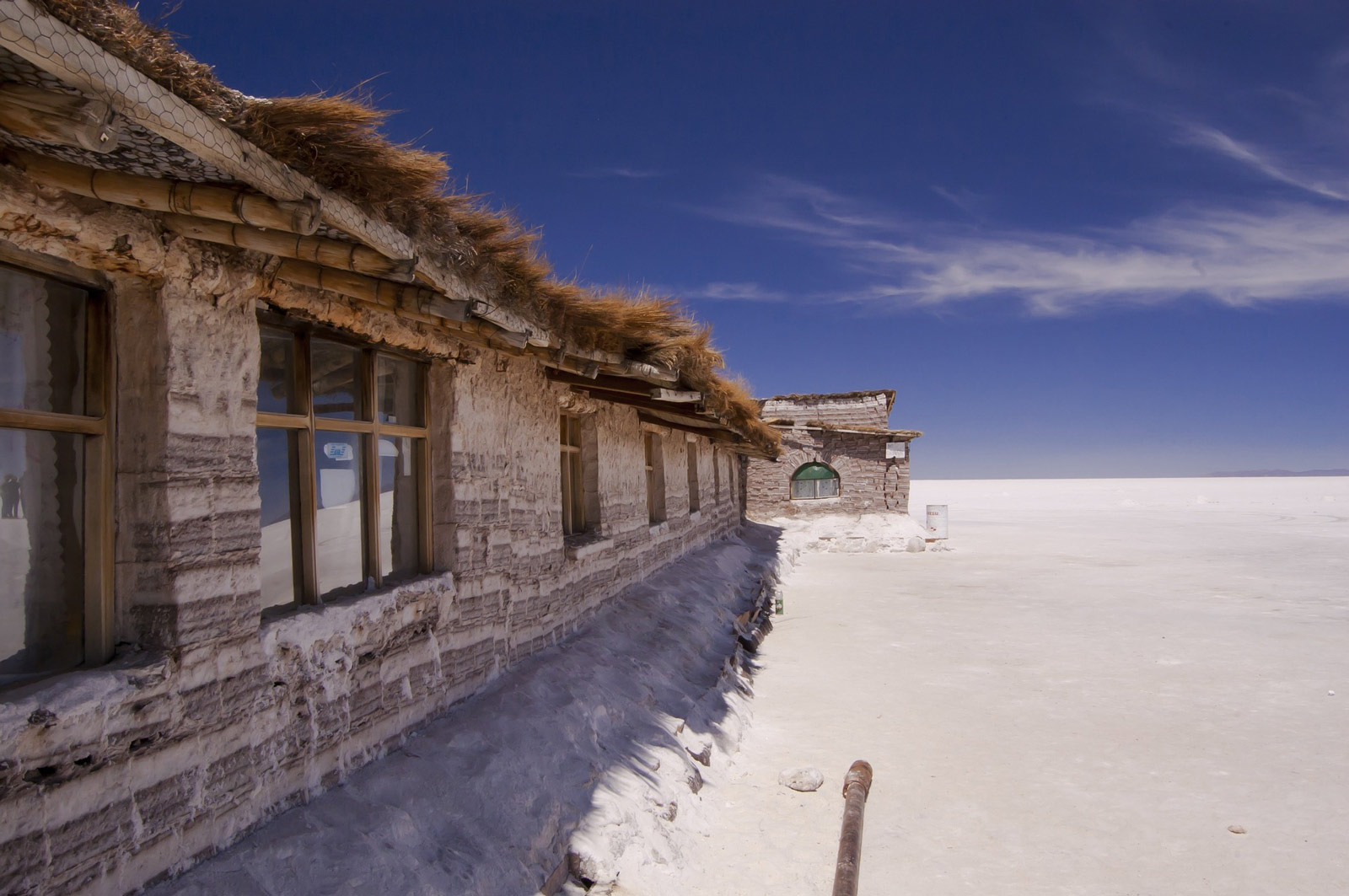
While tours themselves are markets as basic, I would say that we were pleasantly surprised. We have stayed in some basic places over the years but were fairly impressed when you consider the cost of the tour.
You will spend the first night of the tour in a salt hotel, which we loved. Now when I say a salt hotel, I mean everything is made of salt. The hotel exterior is made of salt blocks, the chairs, ground, and bed are also made of salt. We were happy to have private rooms on the first night to really enjoy it. There was also a shower which cost 10BS and had enough water for 2 people. Take advantage of it as there are no other showers on the tour.
The other nights we slept in dorm-type rooms, but you can pay an extra 150Bs for a private room, which we did. The buildings are clean and well taken care of so you never felt like you were on an ultra-budget tour.
There is no WIFI out here so you will be disconnected which we found a welcome reprieve from constantly checking phones each day.
The way the meals are set up is that breakfast and dinner are served at the accommodation and the lunch is always on the road. The food itself was not fine dining but it was tasty and there was always enough.
Where to Stay Near Salar de Uyuni
While there aren’t many accommodation options directly on the salt flats themselves, the nearby town of Uyuni offers various choices for visitors. Here are some suggestions on where to stay:
Uyuni town: This is the most convenient place to stay as it offers a range of hotels, hostels, and guesthouses catering to different budgets. You’ll find options ranging from basic accommodations to more luxurious hotels. Staying in Uyuni allows you to easily access Salar de Uyuni and other nearby attractions.
Colchani: Situated on the edge of Salar de Uyuni, Colchani is a small village known for its salt processing industry. It offers a few accommodations that provide a unique experience closer to the salt flats. Keep in mind that the options may be limited compared to Uyuni town.
Salt hotels: Some unique accommodations are built entirely from salt blocks, providing a distinctive experience for visitors. These hotels are typically located on the outskirts of Uyuni and offer a blend of comfort and the chance to immerse yourself in the salt flat surroundings.
Palacio de Sal is a luxury hotel and spa that was the first salt hotel. Located near the entrance of Salar de Uyuni near Colchani, this is a popular place to stay.
Salt flats camping: For an adventurous experience, you may consider camping on the salt flats. There are tour operators that offer overnight camping trips, providing tents, sleeping bags, and meals. This option allows you to witness the stunning sunsets and starry nights of the salt flats.
How to Dress for a Salar de Uyuni Tour
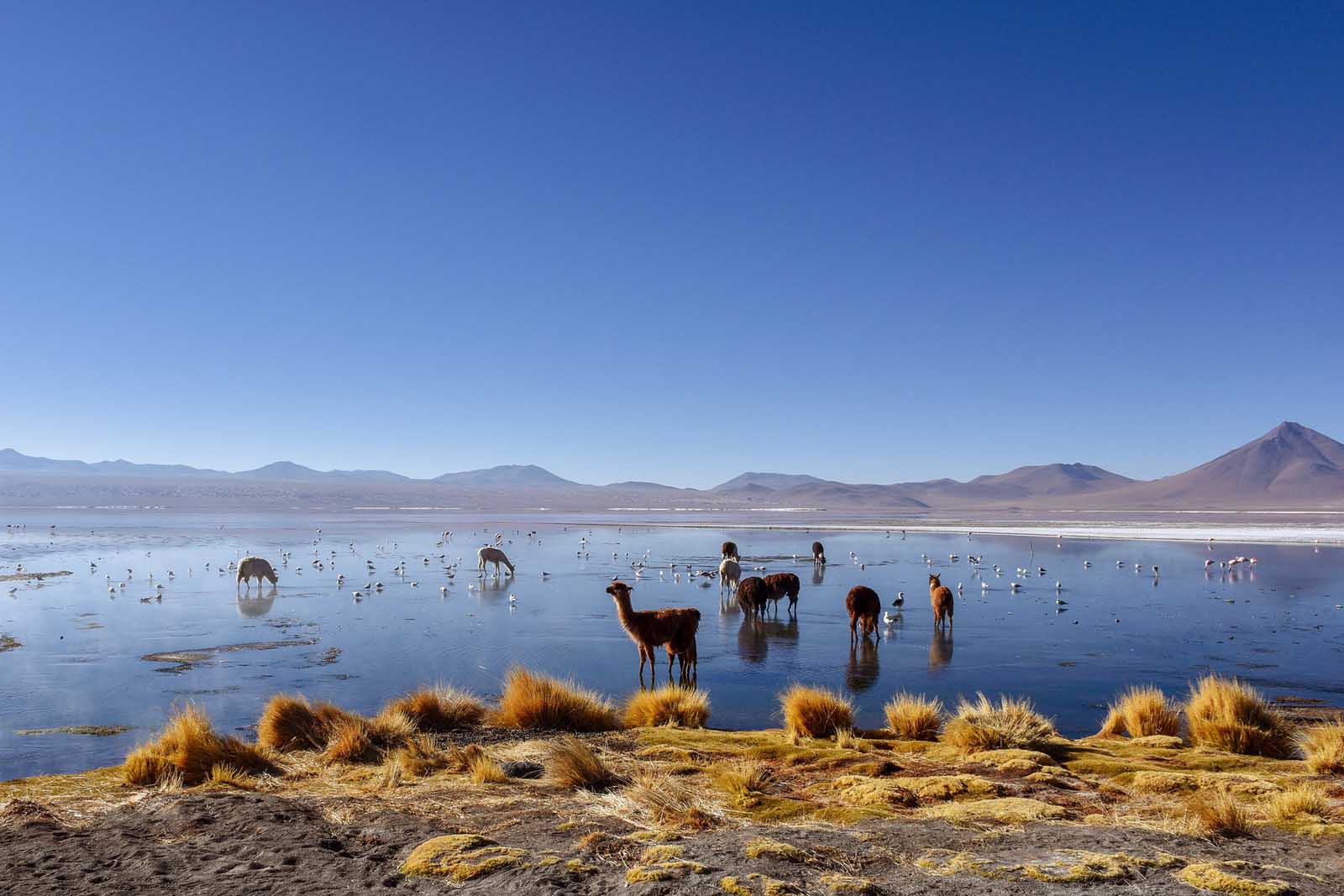
Travel through Bolivia’s southwest corner means splitting your time between extreme warmth, under the startlingly hot midday sun, and extreme cold, when the chilly high altitude nights creep in.
It’s a good idea to dress in layers–that way, you can layer up as the sun drops, then shed clothing again when it rises. During parts of the Uyuni tour, temperatures can drop as low as -15 degrees celsius, so it’s vital to make sure that you have some warm clothes packed. Read our layering tips for packing.
How to Get to Salar de Uyuni
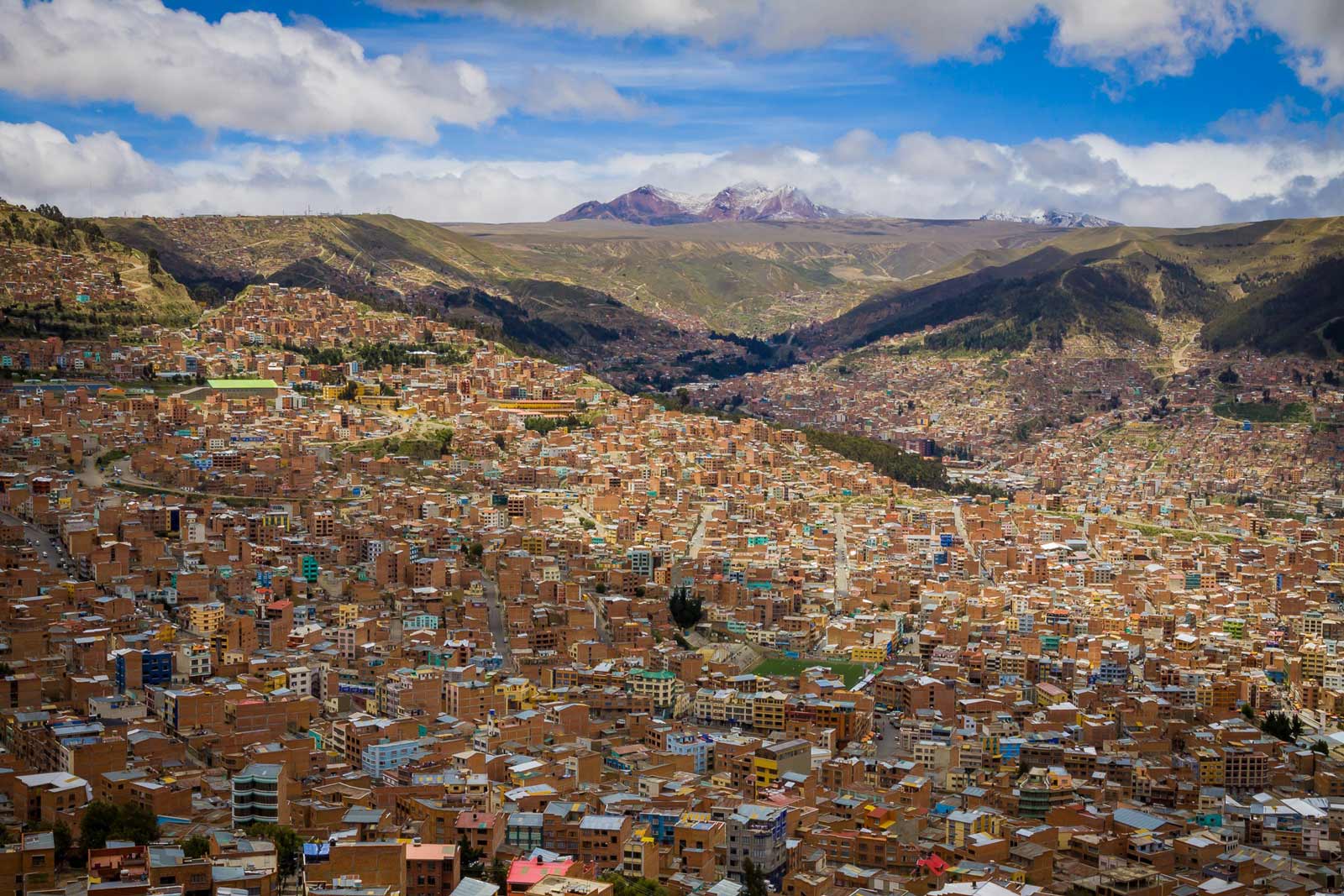
From La Paz to Uyuni
The buses from the de facto capital of La Paz to Uyuni are increasingly geared to tourist comfort, as the Salar de Uyuni becomes a more and more ubiquitous stop among backpackers in South America. The bus from La Paz takes 8 hours and gets you into Uyuni at about 6 am.
This is plenty of time as most tours do not start until 10 am. It is an overnight bus, so you will save on a night’s accommodation if you sleep. It will cost you about $25 USD for the overnight bus and you can check out tickets with https://www.ticketsbolivia.com/
It is recommended to stay a night in Uyuni to acclimate to the altitude.
If you have some extra cash or are limited on time then you can also fly to Uyuni from La Paz. It costs about $100 USD and is often included with private tours from La Paz.
From Sucre to Uyuni
If you are coming from the capital of Bolivia, Sucre, you can catch a direct bus to the Uyuni Salt Flats. The bus ride usually takes about 8 hours. It leaves from the bus terminal on Avenida Ostria Gutierrez in Sucre at 9:30 am and 8:00 pm. It will cost you approximately 11 USD. Make sure to check the times and cost on TicketsBolivia.
If you want, you can book an organized 1-day tour from La Paz to Uyuni salt flat. At the end of the tour, you will return to La Paz.
What
When is the Best Time to Visit the Bolivian Salt Flats?
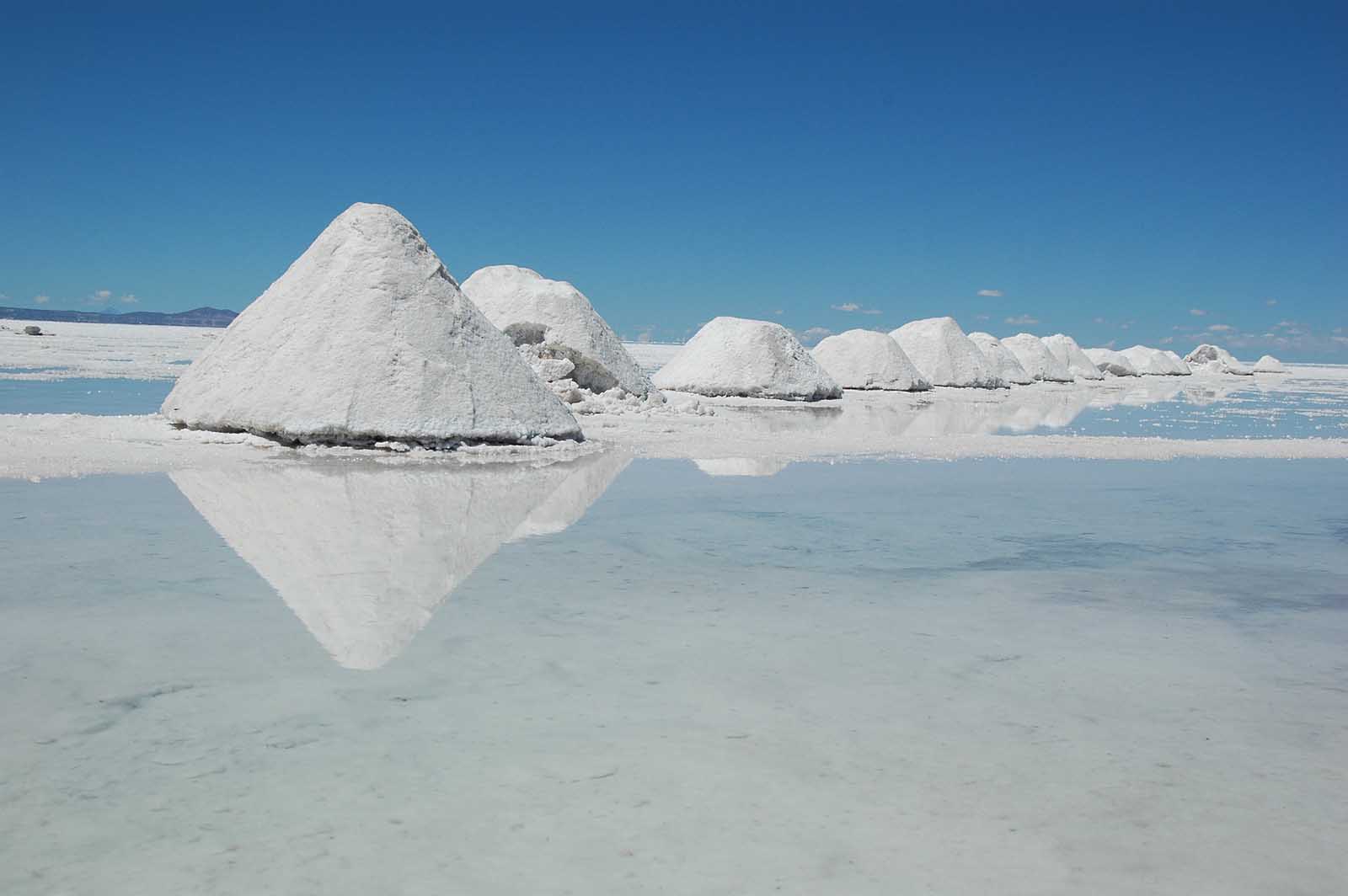
There is no bad time to visit the Bolivia Salt Flats. It really depends on the experience you are looking for.
Rainy season: If you want to see reflections of the salt lake, the rainy season is a good time to visit. The salt flats flood and transform into a massive mirror that reflects the sky and creates an other-worldly experience. During this time of the year there is little to no wind and usually clear skies. Perfect for a photographer. The rainy season in Bolivia is from December to April. Just be aware that during the rainy season a lot of the surrounding attractions are closed.
Dry Season: We visited during the dry season and it was spectacular as well. It is warmer during this time from May to November. Since we visited during the dry season, our SUV produced a giant cloud of dust when we crossed the stunning moon-like landscape of Bolivia’s Andean Plateau making for surreal images.
What you will See on a Bolvian Salt Flats Tour
Isla del Pescado
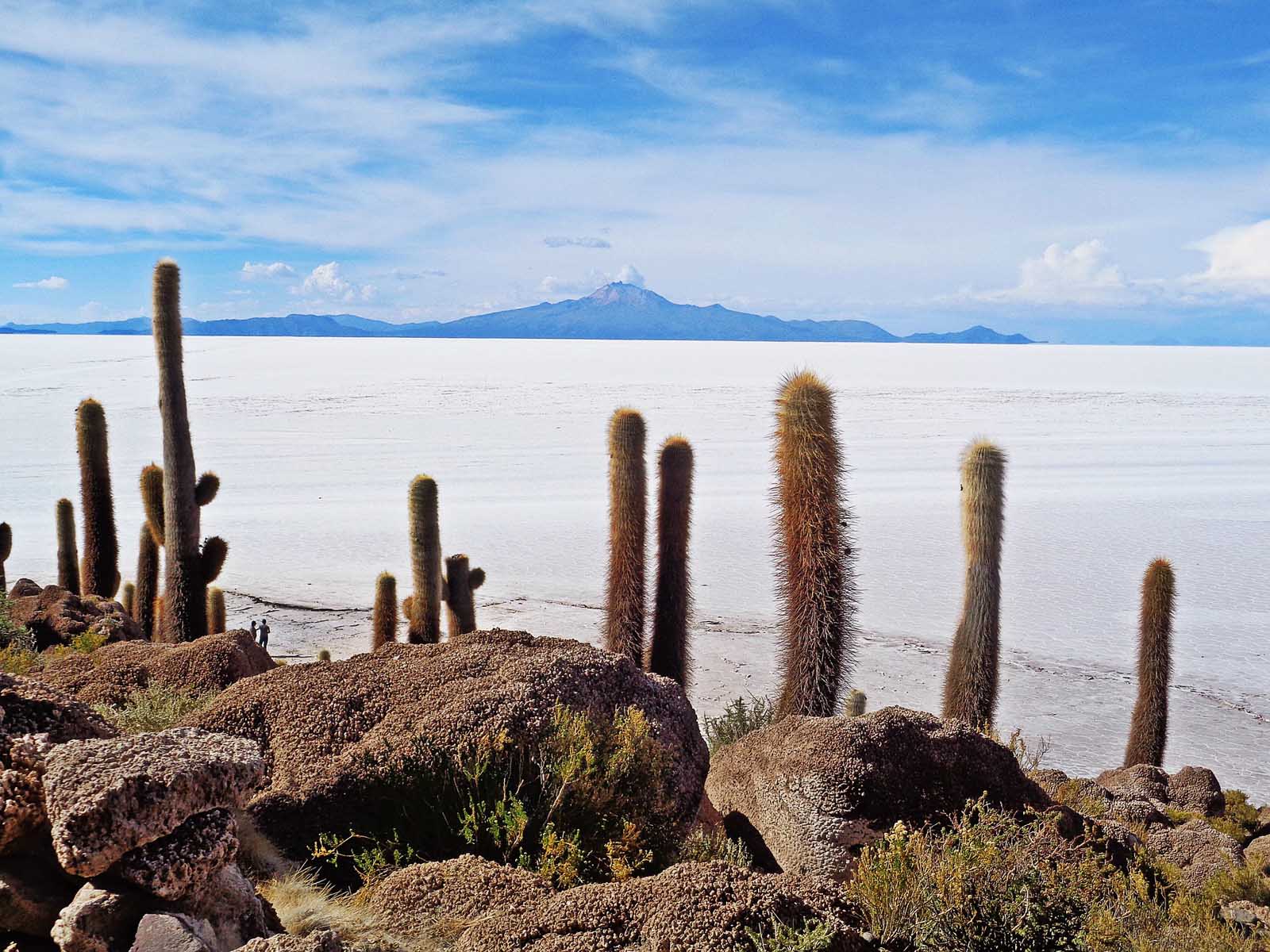
Have you ever seen an island that is NOT surrounded by water? Welcome to Isla del Pescado, the Fish Island! The Salar de Uyuni has a few islands and we enjoyed an awesome view from the top of this one. From up there, we got an impression of the true dimension of the salty landscape.
Steam Locomotives – Train Graveyard
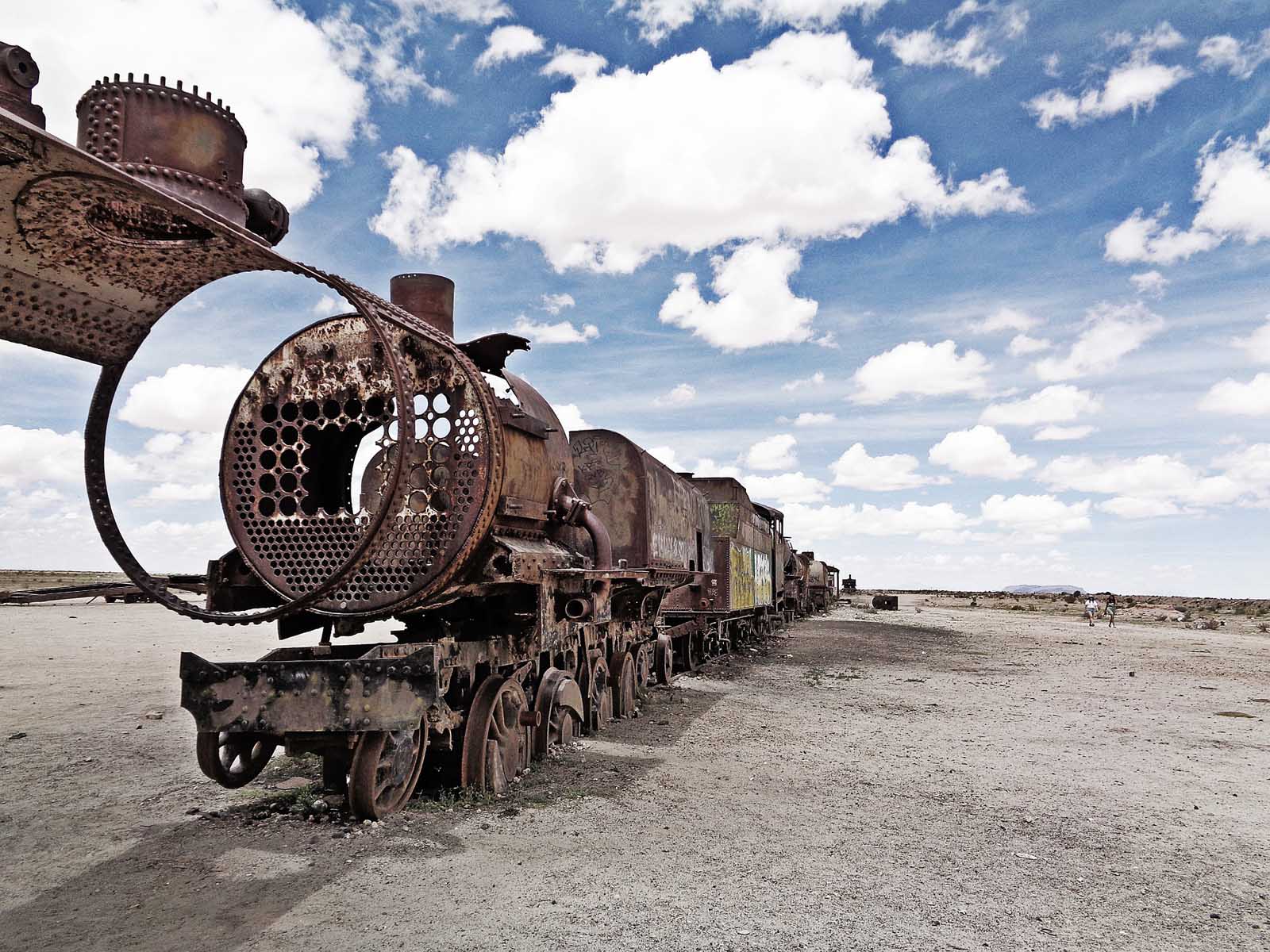
We arrived in Uyuni and jumped out of the SUV and climbed up the giant wrecked old steam locomotives. At that point, we did not know that the adult’s playground was just behind the corner, Uyuni’s train cemetery. The trains are leftover from a time when they carried minerals from the Salar de Uyuni to the Pacific Ocean.
Bolivia’s Andean Plateau
In the Andean Plateau, at an altitude of about 4,000 meters, not only the air is breathtaking. This is what real adventures look like. This is where the SUV feels at home.
The chain of volcanoes and mountains along the horizon gave us the feeling of being far away from any civilization. And for a second we thought we reached the “end of the world”.
The tracks might look like remains from centuries past but they are still in use and connect Bolivia with Chile. The moon-like landscape surrounded us as we drove on the red and brown sand when unexpectedly, behind a hill, a beautiful lagoon appeared.
Lunar Landscape
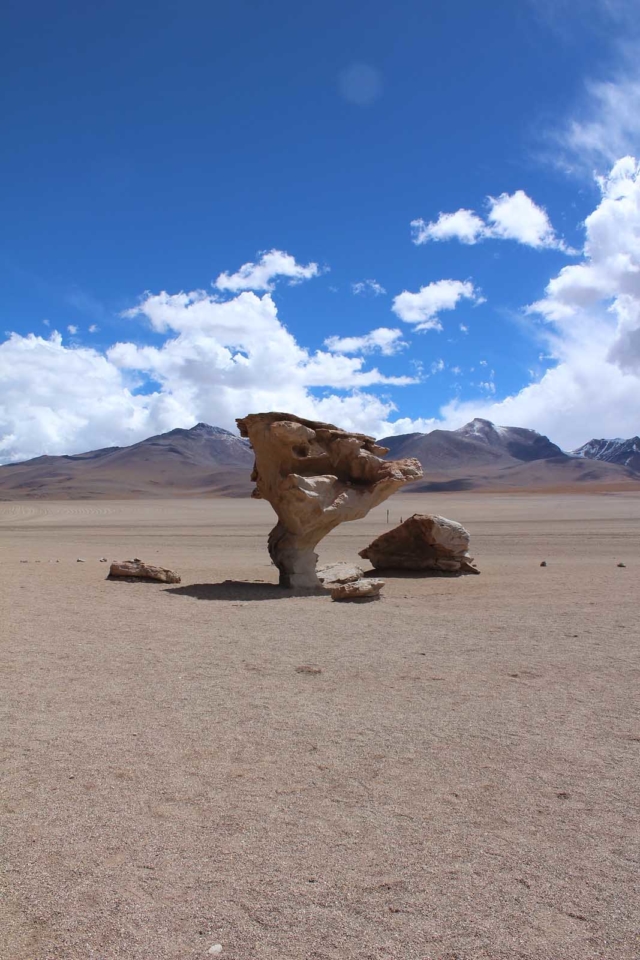
The Andean Plateau and its mysterious rock formations have been formed over millions of years through wind and sand. And sometimes nature is very creative and forms rocks like the Arbol de Piedra, the Stone Tree.
Our guide told us before that we would get to see a lagoon more beautiful than the one we had seen before. But we did not want to believe him as we could not imagine that it would be possible.
Flamingoes
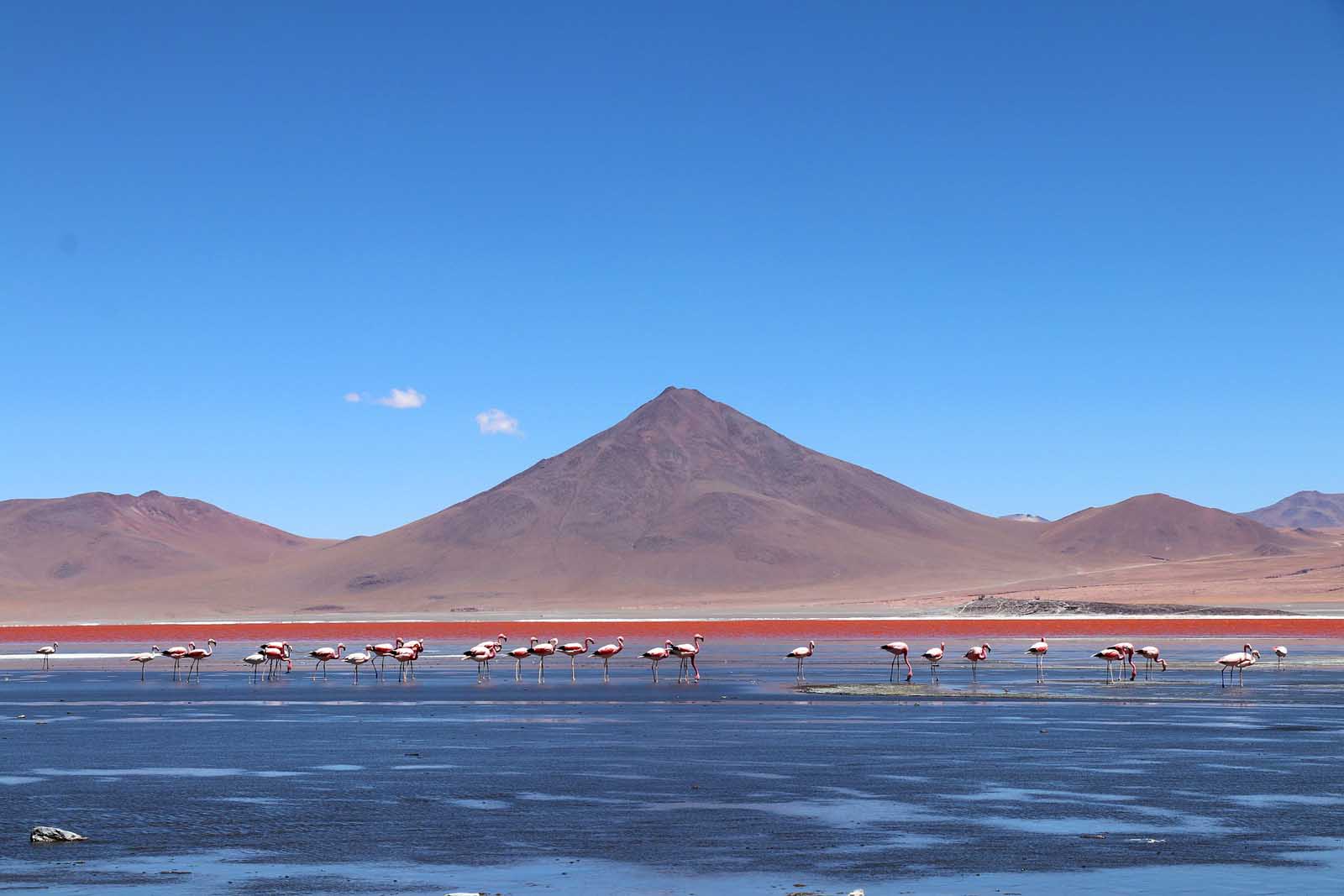
Hundreds, probably thousands of flamingos were wading through the shallow water in search of food. It was such a contradiction to see an oasis of life in the middle of the barren scenery.
Laguna Colorada
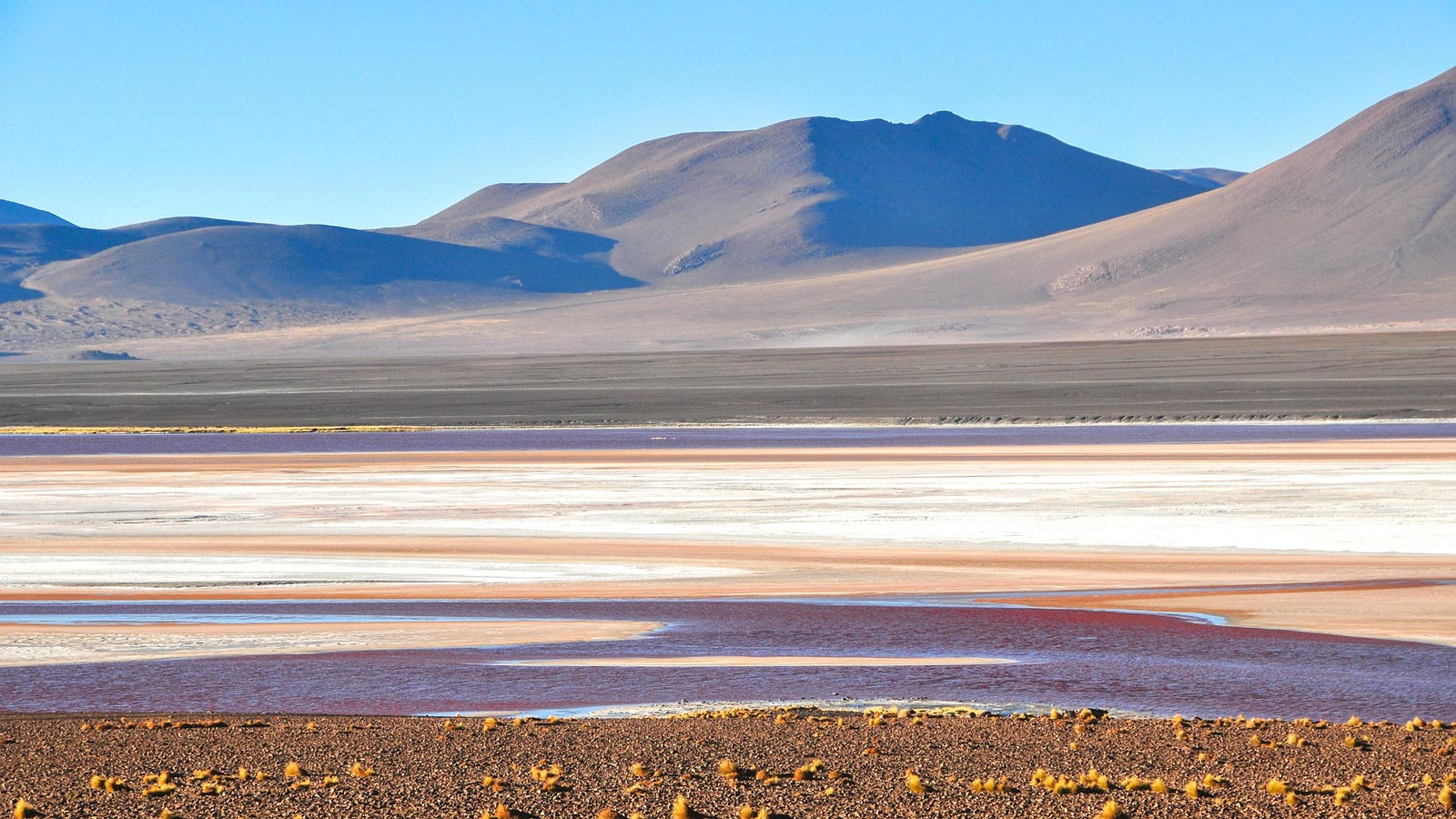
The silence was around us when we approached the Laguna Colorada, the Red Lagoon. Everything around us felt unreal. Do you know how it feels when you see something and cannot believe it is real? It was hard to believe that this lagoon, with its shades of yellow, black, white, red, brown, and the blue sky above it, was not a canvas.
Now and then we saw these little pink spots again, flamingos that enjoyed the delicious alga which makes the water appear red. It was almost sad to see that the last lagoon we visited, the beautiful Green Lagoon with the picturesque volcano in the background was void of flamingos.
As we learned this green type of algae was poisonous. Too bad, the water looked so inviting with those beautiful reflections on the surface.
Sulfur Geysers
Visiting a steaming geyser is a highlight of the Uyuni Salt Flats tour; I was so distracted taking pictures, I almost fell in! It was a very special place our driver took us to watch the sunrise in the early morning.
We were surrounded by geysers and holes in the ground filled with boiling mud. The cold air of the morning intensified the steam and the area looked like a mystic place. After leaving the salt flat we thought it could not get any better. But we were so wrong!
Photos of Salar de Uyuni
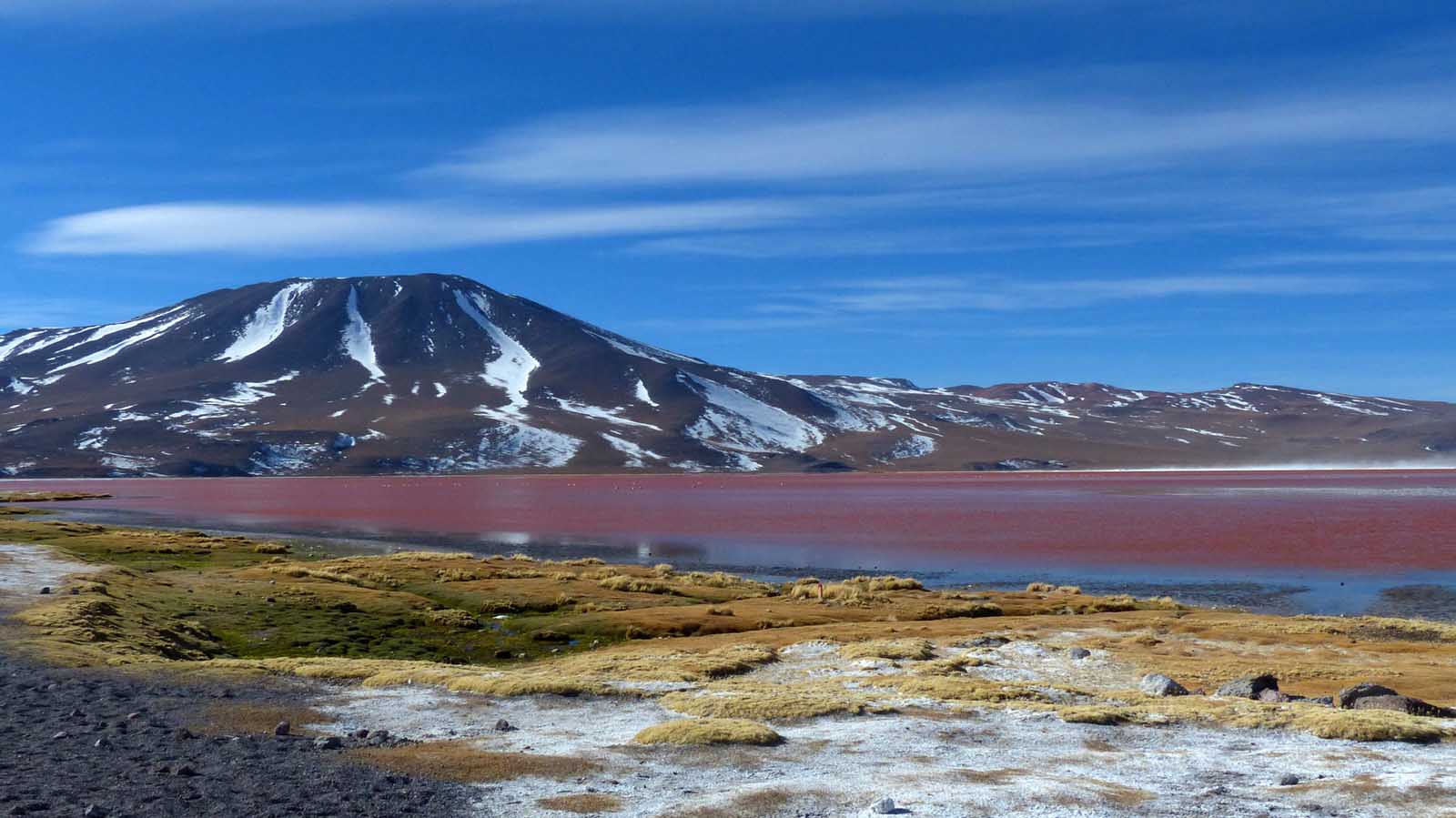
The Uyuni Salt Flats is THE photo spot to play with proportions and perspectives when taking photos. It’s a place where people sit on potato chips cans, toy dinosaurs come to life chasing travelers, and jumping over an SUV is a breeze.
On short photo stops, it can be hard to decide whether to take pictures of the scenery or simply take the scenery in. For those inclined to snap, it’s important to pace your photographic zeal. The landscape is so marvelous, it’s simply impossible to catch it all. In other words, it’s a road trip like no other, and absolutely worth doing.
Common Questions About Doing a Salar de Uyuni Salt Flats Tour
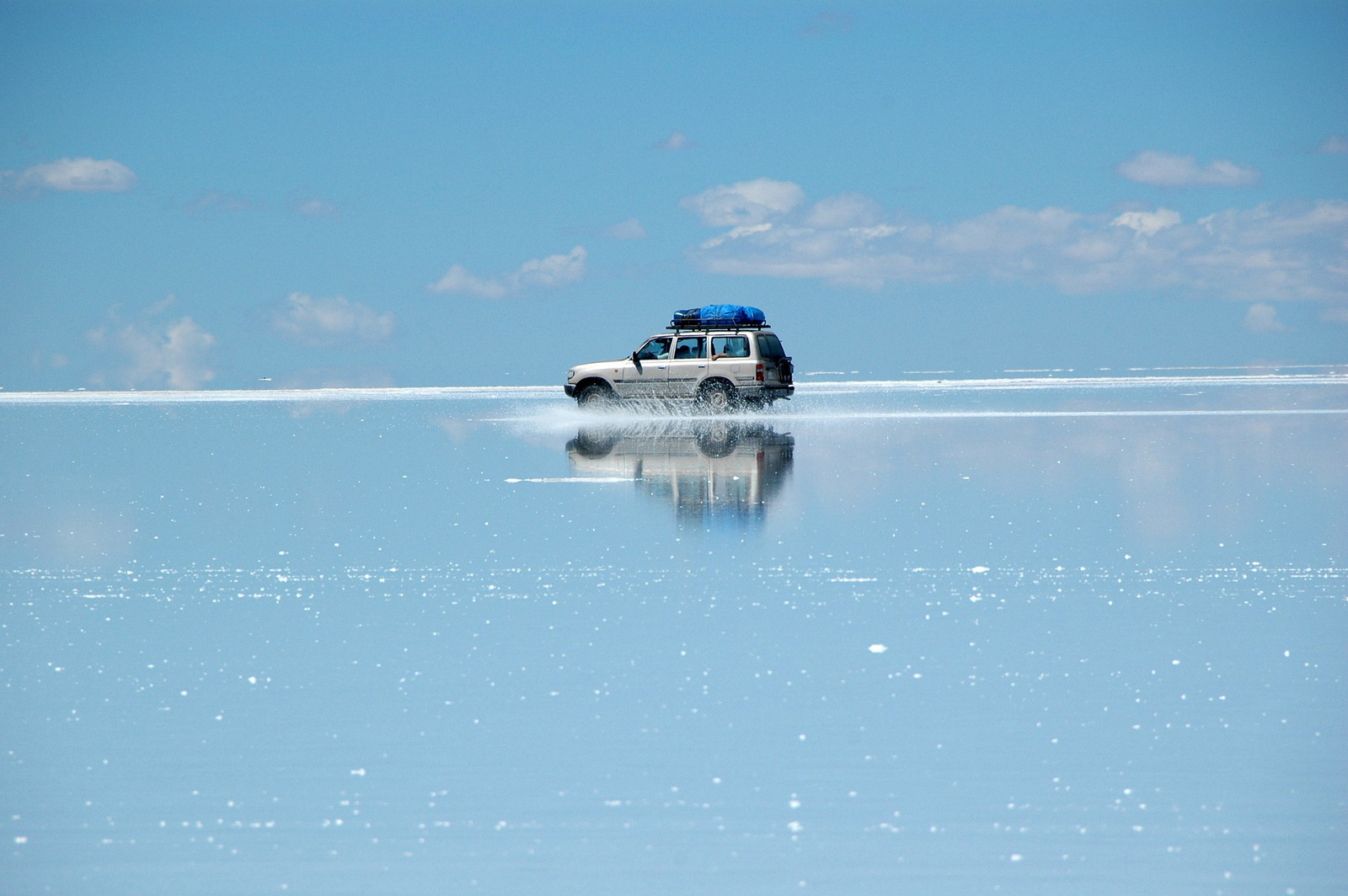
Do you need an English Speaking Guide?
The answer here is it depends. If you speak fairly fluent Spanish then you can definitely forego an English guide. If you do not speak Spanish at all then we recommend paying the extra money (it can be up to 500 Bs per person) and getting an English guide.
We like to understand our guide as they can provide a lot of background information on the area and there is the added advantage that if you pay extra for the English guide you will have only English speaking people in your car. When you are together for 3 or 4 days this was important to us.
That being said, if you want to save some money and you are on a tight budget, the Spanish-speaking guide is fine. You will be able to make out most of what he is saying anyways. It is important to note that if you opt for the English-speaking guide that there is usually one guide for every 2 or 3 cars from that tour company.
What altitude are you at in the Salar de Uyuni?
You are at altitude when you are in Uyuni, Bolivia. The town itself sits at more than 3500m or 12,000 feet and that is just where you start. During the tour, you will reach altitudes of up to 4800m or 15,000 feet at the Laguna Colorada, in the Eduardo Avaroa National Park. So be prepared.
We recommend spending at least one day in Uyuni before your tour to acclimatize to the altitude. Dring plenty of liquids and don’t exert too much effort physically. You will be out of breath a little on the first day but should get used to the lack of oxygen quickly.
Will it get cold?
The short answer is yes. Even though the weather during the day can be pleasant, you have to remember that you are at altitude so the nights can get quite cold. If you are someone who gets cold easily you might want to bring your own sleeping bag or ask to rent one from the tour operator.
Will I have phone or internet during the tour?
The fact is you will be in the middle of nowhere so there will be little to no internet or phone signal during the entire trip. It is a good time to relax and disconnect from the world and enjoy the nature that is all around you. If you are in desperate need of internet or a phone there is a place on the second day that offers paid internet access.
Cash or Credit Card? Which is Best?
Cash is king when you are on your trip to the salt flats in Bolivia. There are some ATMs in Uyuni but we suggest having local currency on hand before you arrive just in case. Make sure that you have local currency as that is required especially if you want to visit the following:
- National Park Entrance Fee: 150 Bs ($22 USD) per person
- Fish Island: 30 Bs ($5 USD)
- Hot Springs: 6 Bs ($1 USD)
What should I pack?
Packing for the salt flats is really dependent on where you are going to finish your tour. If you are carrying on to The Atacama Desert in Chile you will bring your full backpack. We do suggest putting the everyday items in a day pack so they are easily accessible as your pack will be on the top of the 4X4 each day.
If you are starting and ending in Uyuni then it is possible to leave some items in the hotel so you don’t have to bring everything. That being said, the shifts in temperature can be quite drastic so you want o to be prepared. Here is a list of things you should pack for your tour of the Salt Flats in Bolivia:
- Sunscreen with high SPF, sunglasses, hat and lip balm are a must.
- Layers of warm clothes. Temperature fluctates drastically between day and night.
- Hiking boots (Older ones if you are visiting during the wet season)
- Travel towel for the first night shower and the hot springs.
- Gold Bond: To keep yourself fresh.
- Camera and extra batteries fully charged.
- Headlamp
- Water bottle and water. Even if it is provided it is good to have extra.
- Cash in local currency.
- Swimsuit if you pan on going in the hot springs.
- Flip flops or running shoes for at the hotel.
How Do you Describe the Salt Flats in Bolivia?
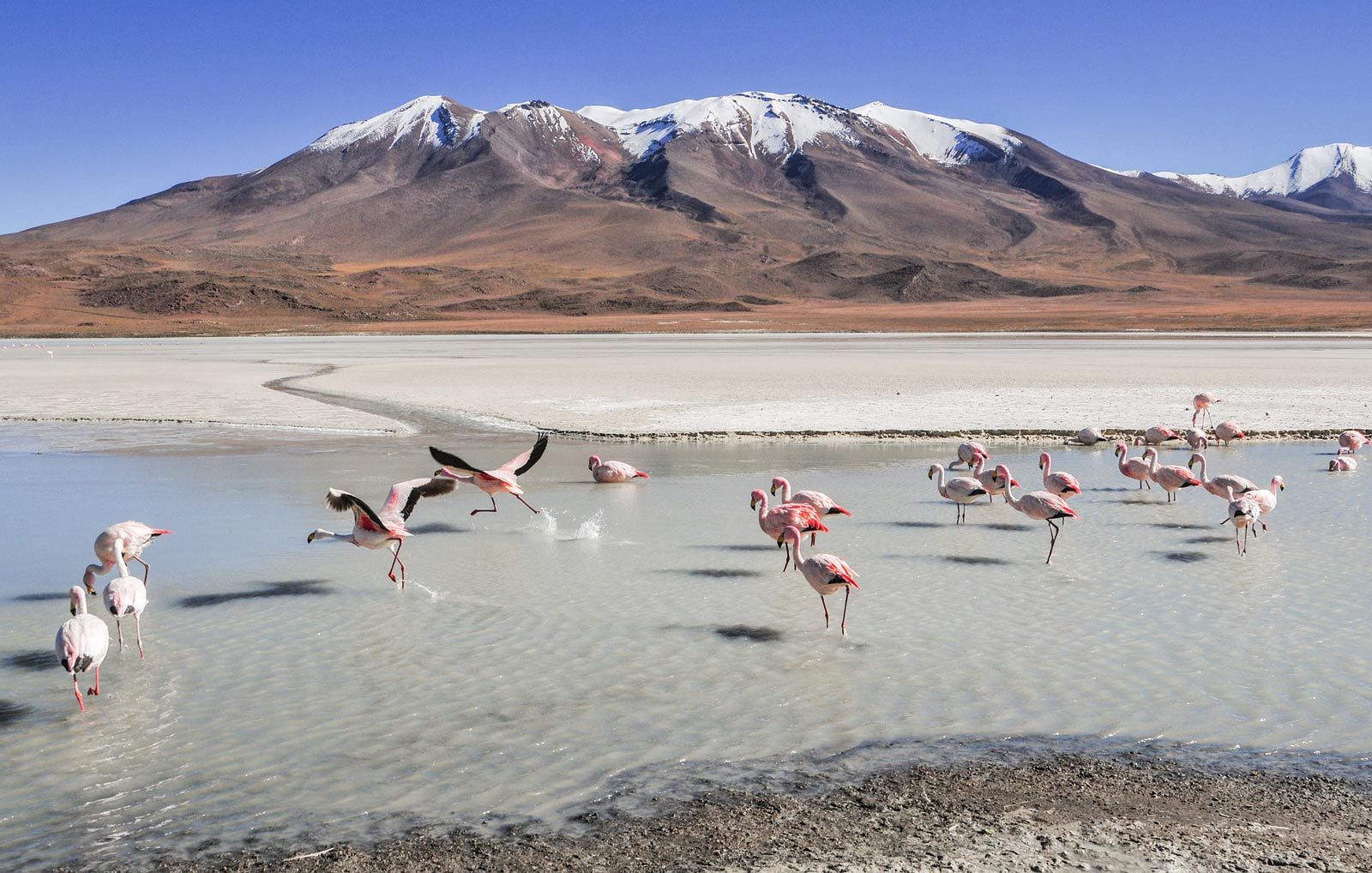
Salty, white, endless… these three words best describe the Salar de Uyuni. The sun burned from the sky and the reflections from the salt were so strong that it was impossible to open the eyes without sunglasses while looking over the massive salt desert. After a while, the awe can be a bit overwhelming. It’s as if nature is trying to beat you into submission with so many amazing things.
Most Salar de Uyuni tours can feel very start and stop, with the driver rendezvousing with other tourist jeeps at designated points for all-too-rapid photo opportunities. It’s a surreal sight, as the southwest roads of Bolivia appear entirely deserted but for the jeeps gathering in small groups to disgorge their tourist cargo.
Final Thoughts
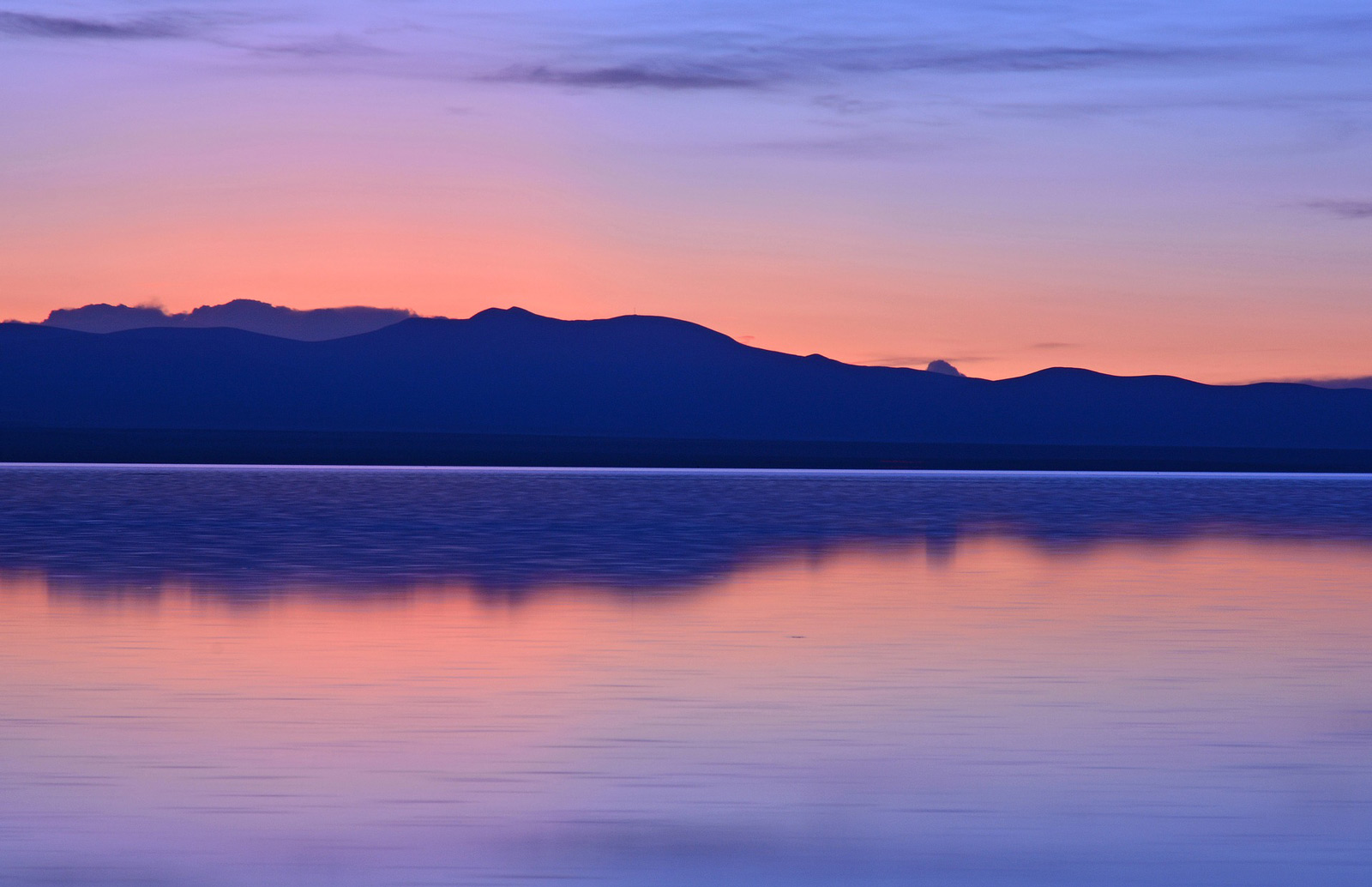
We drove across Bolivia’s scenic southwest corner, a staggeringly beautiful region bursting with mountains, lagoons, and inactive volcanoes. Equipped with many big containers of drinking water and thick sleeping bags our driver put the SUV into first gear and an amazing adventure through barren surroundings began.
It’s an experience that involves gorgeous vistas, extreme cold, and days without showering.
At the end of our 3-day trip, we were exhausted. Exhausted because of all the incredible things we had seen.
It started with an endless white salt flat, continued with moon-like sandy and dry landscapes of volcanoes and mountains, and ended with the most colorful lagoons we had ever seen. Every one of us needed some time to digest the past days.
There are many amazing places on our blue planet but the Salar de Uyuni and everything around it truly belongs to one of its most beautiful places! The Salar de Uyuni remains one of the world’s most fantastic locations–and since it’s in Bolivia, one of the most affordable, too.
Bolivia’s frontier feel means the trip sometimes seems akin to stepping out of the charted territory, onto a succession of different planets.
Sticking Around Bolivia
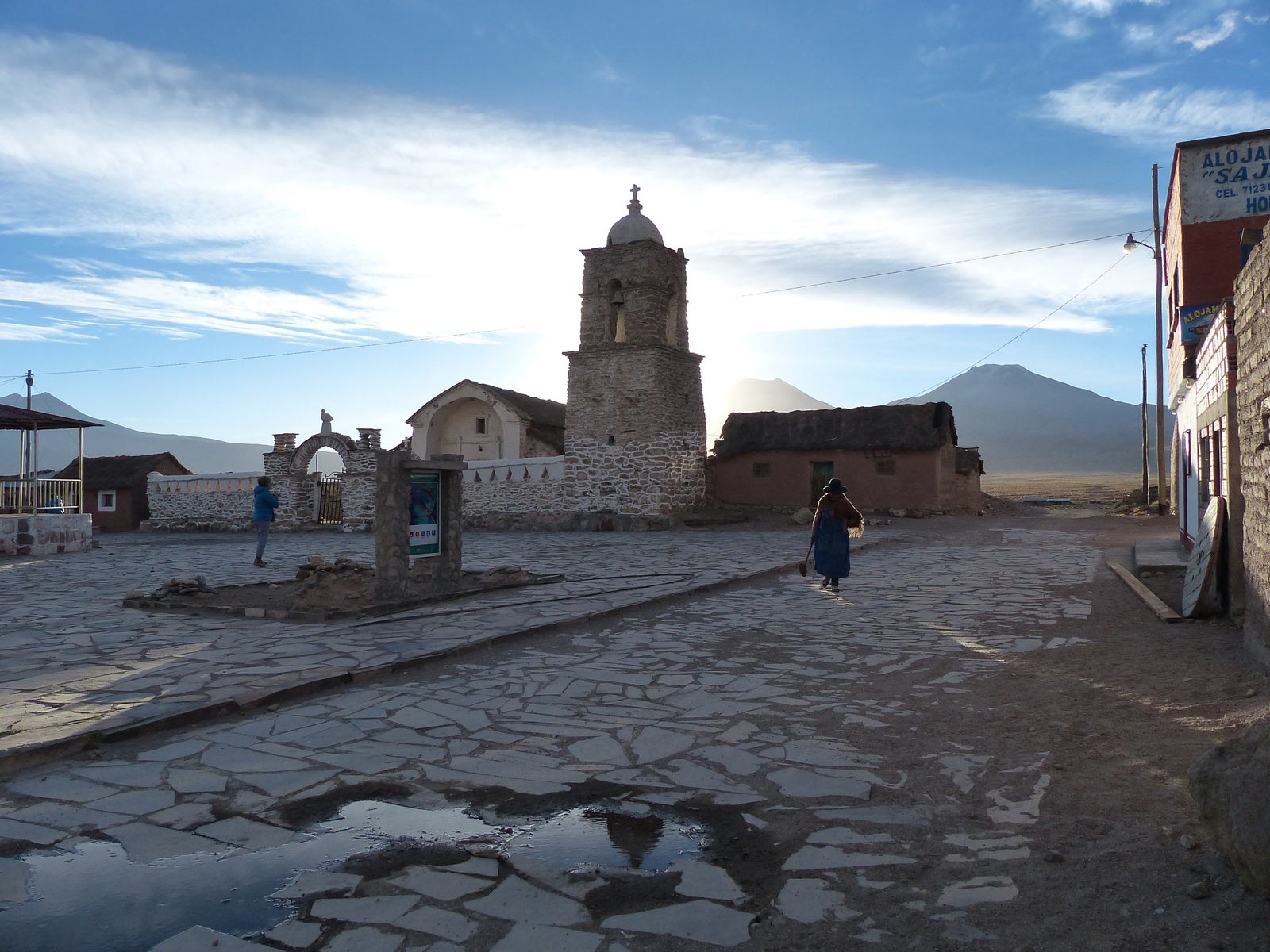
But while the Salar is undoubtedly a highlight, the rough remainder of Bolivia should not be ignored. From the grungy mining city of Potosi to the gothic streets of La Paz to the verdant jungle reaches of the Amazon, Bolivia is filled with breathtaking and bizarre sights. Once you’ve seen the Salar (or even before), consider sticking around to take a few extra destinations in.
If you’re looking to venture along the edge of the world or race across some of nature’s most striking vistas, there is no better destination. So strap in, buckle up, and don’t forget to bring shades. There’s a white desert waiting, made of salt and blinding sunlight.
Have you been to the Bolivia Salt Flats? What do you think? Is Bolivia’s Andean Plateau one of the most beautiful places in the world?
This article was originally written by Liane and Lars of bobaroundtheworld.com who have since stopped blogging, but we have kept it on ThePlanetD as it is a destination that is worth visiting.

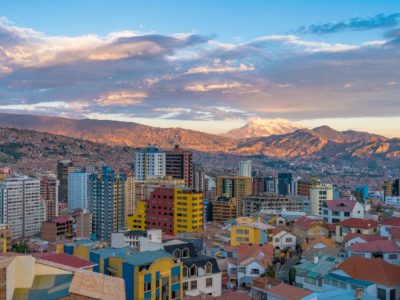
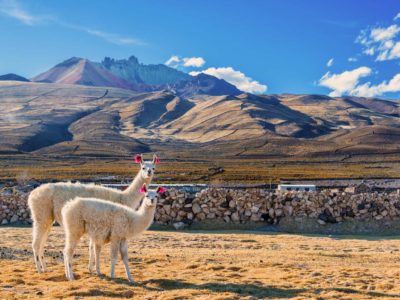
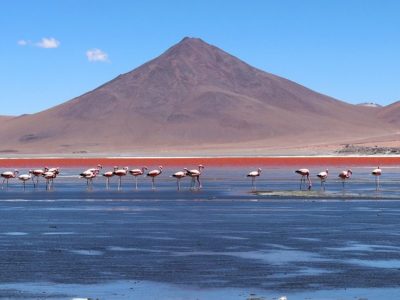
Chile is a very nice place to visit.
This is relay amazing picture. i am from country of world hugest peak Mt Everest 8848 m and light of Asia. Nepal is on of the best destination for hiking and sightseeing, so traveler get lots of opportunity to take unlimited amazing capture during the adventure and the tour. where the incredible scenery attract to the traveler as well as photographer to explore them on unique feature. which may motive to the traveler.
What a great photo and article, this is really awesome!!
thanks for sharing with us and keep posting such a great pics
Me from Everest Country Nepal, As a traveler all pics are so amazing and thanks for sharing such a great pics and articles.
We have the big mountains like Everest 8848m. but we don’t have such awesome places.You are a really wonderful photographer.
wow, this are the most beautiful pictures, I rally love it, thanks for sharing
Incredible adventure. Hope that you have enjoyed a lot on this trip.
Appreciate for your great effort to share your travel experience.
Great Adventure. There is a quietness and bareness of these lands that makes you feel like you are at the end of the world.
The flamingos in the salt/soda lakes are similar to what we have in Kenya and Tanzania lakes nakuru, bogoria and lake manyara. Awesome.
Wow, what an incredible place! I’ve seen tonnes of photos of the flats but never of the surrounding regions/sites/wonders. Great insight into somewhere I’d absolutely love to visit! Thank you.
Wow, incredible journey. It seems like you have enjoyed your trip. Awesome photographs. Your blog is very informative to all those travelers who pursue adventure.
Appreciate it for sharing your travel experience.
Incredible pictures! you shared awesome place to visit and great detail.. Really want to go there, Thank you so much for sharing a nice experiences..
keep posting!
Awesome photos guys. What company did you go with and did you like going with them?